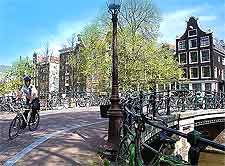World Guides Travel Blog
October 2012
This is where we let you know all about what's going on with our website and the world of travel, with destination reviews, current travel news and topical travel-related stuff to discuss with your friends. Please let us know if you want to comment on anything -
Contact us.
October 26, 2012
GOING FOR GOLD THIS AUTUMN

It is autumn. In my book, that means it is time to hunt out woolly jumpers and boots, pack a flask of hot soup and venture into the great outdoors. And there is no place better to head for than Stourhead, a National Trust-managed estate in
Wiltshire,
England, that is guaranteed to offer some stunning autumn scenes.
Over the years, Stourhead has become renowned as one of the best places in Britain to view this natural and quite spectacular phenomenon. Now that this year's distinctly chilly autumnal weather has well and truly kicked off, the estate's hundreds of native and exotic trees are doing what they do best - gradually metamorphosing into a warm colour-washed wonderland.
Henry Hoare II, who was the 18th-century brainchild behind Stourhead's gardens, can hardly have imagined the flurry of 21st-century visitors and photographers armed with long lens who descend for a few weeks each year to capture everything from vivid blood red acers to coppery beeches and yellow-tinged tulip trees.
One thing's for sure, though. At Stourhead, no two years are ever the same. This year, for example, the unusually wet weather conditions have led to an incredibly rich autumn landscape. Of course, you can't help but wonder whether you are going to catch the leaves at their best. Arrive too early and the leaves have hardly begun to show their true colours, and arrive too late and you are in danger of missing out on the last golden leaf as it flutters earthward.
That is where the Stourhead Leaf Line, a phone service that gives daily advice on autumn happenings in the garden, comes in handy. I gave it a ring today and I was delighted to hear the head gardener's reassuring voice on the other end. There is still plenty of autumn left at Stourhead, by all accounts. Thank goodness for that.
Posted by Sue at 15:27:28 on 26/10/2012
October 19, 2012
CATCHING THE CYCLING BUG

This summer, the London Olympics sparked off a sudden interest in all sorts of sports, from tae kwon do to beach volleyball. Following hot on the heels of the Tour de France, it also led to a dramatic British revival in all things cycling-related. The 'Bradley Wiggins effect', as it is come to be known, has set into motion a real riding craze - and it is still gathering momentum.
I can, at least, claim to be one step ahead, because I ordered a new road bike way back in the late spring. It finally arrived a few weeks ago, and the silly grin has barely left my face since. By all accounts, I'm not the only one. Bike sales here have rocketed in recent months. Cycling clubs have also seen unprecedented levels of interest and Internet searches on the word 'cycling' have doubled.
Taking to two wheels has been something of an eye opener. There is a whole new armoury of equipment to consider, for a start. Cleated shoes and bottle cages spring to mind. There is also an endless choice of cycling routes to be explored, from close to home to further afield. For me, it is easy enough to head out of the door. Quaint country roads and a cycle path are all within a short pedal distance. True, some of those country roads aren't as tranquil as you would like, but there is still no better feeling than making it to the top of a hill (without having to get off to push) and whizzing down the other side.
The prospect of cycling further afield is also very appealing, especially when the nights are drawing in and the weather forecast doesn't look particularly bike-friendly. Where to go, though? Recently, a friend brought back a glowing report of a cycling holiday in
France - Provence, to be exact. Apparently, it is possible to peddle to your heart's content on picturesque French roads that are remarkably traffic free. Great cycling terrain can be easily combined with good food. It doesn't take much to imagine pulling off the road to enjoy an al fresco lunch of fresh bread and cheese, or stopping for the 'plat du jour' at a roadside bistro. Perhaps the biggest plus, though, is that French motorists are known for being well attuned to sharing the road with the two-wheeled fraternity.
Even further down the road is Italy, a cycling dream of a place, and
Spain, a country that boasts an abundance of scenic roads - not to mention the bicycle-loving Dutch. All in all, there is enough out there to keep cyclists like me happy for quite some time.
Posted by Sue at 21:30:23 on 19/10/2012
October 12, 2012
BRINGING EGYPT'S TOMBS BACK TO LIFE

If I had to write a list of 'must-see' destinations before I die, then
Egypt would be at the very top. Once off the plane, you wouldn't see me for desert dust. I'd make a beeline for those most fascinating and enigmatic of historical landmarks, the Egyptian pyramids. They're what makes Egypt so special.
Whilst last year's political disturbances are still something of a deterrent for many tourists, this might not actually be a bad time go pyramid-visiting. Some of the top archaeological sites - usually awash with crowds and coaches - are quieter and more low key these days. Above all, though, in recent days the Egyptian government has announced the reopening of the Pyramid of Khafre after a period of closure. The pyramid is located south-west of the centre of
Cairo, in the Giza Necropolis, best known for its massive nose-less Great Sphinx sculpture.

The pyramid was built for Khafre, a pharaoh that trod the Egyptian sands some 4,500 years ago. It first revealed its secrets to the outside world as early as the 14th century, although a more comprehensive tally of the pyramid's features didn't appear until the 19th century, thanks to the likes of Giovanni Belzoni and, later, John Perring. Since those heady days of discovery, tourism has taken its toll. Cracks, erosion and an excess of humidity within the pyramid - the result of the combined breaths of millions of tourists - were just a few of the problems encountered during the preservation project.
Now, tourists can walk the arrow-straight passageways of the tomb once again and gaze in wonder at the sheer audacity of it all. From outside, while the Pyramid of Khafre doesn't have quite the same dimensions as it did in the good pharaoh's time, it is still an impressive sight.
This is also the perfect time of year to indulge in a spot of tomb tourism. Those who visit Egypt in the summer need to be made of stern stuff to withstand the heat. Making a winter visit is a far more sensible move. Plus, of course, if Egyptian tourism figures don't take an upturn anytime soon, it is likely that we'll see even greater access to more of the country's most ancient monuments. I will be among the tourists tempted, no doubt, by the chance to witness the tremendous achievement of the people who built them.
Posted by Sue at 19:43:15 on 12/10/2012
October 7, 2012
PLACES WORTH PROTECTING

Britain has 28 of them.
Mexico has 31,
Italy has 45 and
Switzerland a total of 11. The
Great Wall of China is one, so too are the Incan ruins at Peru's
Machu Picchu. I am, of course, talking about UNESCO World Heritage Sites. Nowadays, it is easy to take for granted the fact that places of historic, cultural or environmental significance will be around for us to enjoy for years to come, safe in the knowledge that someone is there to look after them. Before UNESCO's list, though, there was no such guarantee.
In fact, it wasn't until 1978 that the first World Heritage Sites made it onto UNESCO's list. That is despite the fact that fears about places in peril had been debated in the world's corridors of powers for decades.

Today, there are in the region of 900 sites in 145 countries around the world. This figure includes over 200 natural sites. Australia's Great Barrier Reef is one of the largest, along with the Galapagos Islands in Ecuador. Economic crises, wars and environmental threats can come and go, but at least a country's cultural heritage and its inherited natural landscape can, in some way, be protected against the ravages wrought by both time and man.
Britain's UNESCO World Heritage Sites range from the Tower of London, built in the time of William the Conqueror, to the iconic
Stonehenge, constructed considerably earlier and still something of a mystery. However, World Heritage Sites don't have to be hundreds of years old. Take the case of
Brasilia, Brazil's capital. Before the late 1950s, this metropolis of a place was only a twinkle in the urban planner's eye. And the most popular World Heritage Site of them all? Well, it seems that the
Taj Mahal in
India might currently be the proud owner of that particular accolade.
Posted by Sue at 15:09:06 on 7/10/2012
 It is autumn. In my book, that means it is time to hunt out woolly jumpers and boots, pack a flask of hot soup and venture into the great outdoors. And there is no place better to head for than Stourhead, a National Trust-managed estate in Wiltshire, England, that is guaranteed to offer some stunning autumn scenes.
It is autumn. In my book, that means it is time to hunt out woolly jumpers and boots, pack a flask of hot soup and venture into the great outdoors. And there is no place better to head for than Stourhead, a National Trust-managed estate in Wiltshire, England, that is guaranteed to offer some stunning autumn scenes. This summer, the London Olympics sparked off a sudden interest in all sorts of sports, from tae kwon do to beach volleyball. Following hot on the heels of the Tour de France, it also led to a dramatic British revival in all things cycling-related. The 'Bradley Wiggins effect', as it is come to be known, has set into motion a real riding craze - and it is still gathering momentum.
This summer, the London Olympics sparked off a sudden interest in all sorts of sports, from tae kwon do to beach volleyball. Following hot on the heels of the Tour de France, it also led to a dramatic British revival in all things cycling-related. The 'Bradley Wiggins effect', as it is come to be known, has set into motion a real riding craze - and it is still gathering momentum. If I had to write a list of 'must-see' destinations before I die, then Egypt would be at the very top. Once off the plane, you wouldn't see me for desert dust. I'd make a beeline for those most fascinating and enigmatic of historical landmarks, the Egyptian pyramids. They're what makes Egypt so special.
If I had to write a list of 'must-see' destinations before I die, then Egypt would be at the very top. Once off the plane, you wouldn't see me for desert dust. I'd make a beeline for those most fascinating and enigmatic of historical landmarks, the Egyptian pyramids. They're what makes Egypt so special. The pyramid was built for Khafre, a pharaoh that trod the Egyptian sands some 4,500 years ago. It first revealed its secrets to the outside world as early as the 14th century, although a more comprehensive tally of the pyramid's features didn't appear until the 19th century, thanks to the likes of Giovanni Belzoni and, later, John Perring. Since those heady days of discovery, tourism has taken its toll. Cracks, erosion and an excess of humidity within the pyramid - the result of the combined breaths of millions of tourists - were just a few of the problems encountered during the preservation project.
The pyramid was built for Khafre, a pharaoh that trod the Egyptian sands some 4,500 years ago. It first revealed its secrets to the outside world as early as the 14th century, although a more comprehensive tally of the pyramid's features didn't appear until the 19th century, thanks to the likes of Giovanni Belzoni and, later, John Perring. Since those heady days of discovery, tourism has taken its toll. Cracks, erosion and an excess of humidity within the pyramid - the result of the combined breaths of millions of tourists - were just a few of the problems encountered during the preservation project. Britain has 28 of them. Mexico has 31, Italy has 45 and Switzerland a total of 11. The Great Wall of China is one, so too are the Incan ruins at Peru's Machu Picchu. I am, of course, talking about UNESCO World Heritage Sites. Nowadays, it is easy to take for granted the fact that places of historic, cultural or environmental significance will be around for us to enjoy for years to come, safe in the knowledge that someone is there to look after them. Before UNESCO's list, though, there was no such guarantee.
Britain has 28 of them. Mexico has 31, Italy has 45 and Switzerland a total of 11. The Great Wall of China is one, so too are the Incan ruins at Peru's Machu Picchu. I am, of course, talking about UNESCO World Heritage Sites. Nowadays, it is easy to take for granted the fact that places of historic, cultural or environmental significance will be around for us to enjoy for years to come, safe in the knowledge that someone is there to look after them. Before UNESCO's list, though, there was no such guarantee. Today, there are in the region of 900 sites in 145 countries around the world. This figure includes over 200 natural sites. Australia's Great Barrier Reef is one of the largest, along with the Galapagos Islands in Ecuador. Economic crises, wars and environmental threats can come and go, but at least a country's cultural heritage and its inherited natural landscape can, in some way, be protected against the ravages wrought by both time and man.
Today, there are in the region of 900 sites in 145 countries around the world. This figure includes over 200 natural sites. Australia's Great Barrier Reef is one of the largest, along with the Galapagos Islands in Ecuador. Economic crises, wars and environmental threats can come and go, but at least a country's cultural heritage and its inherited natural landscape can, in some way, be protected against the ravages wrought by both time and man.